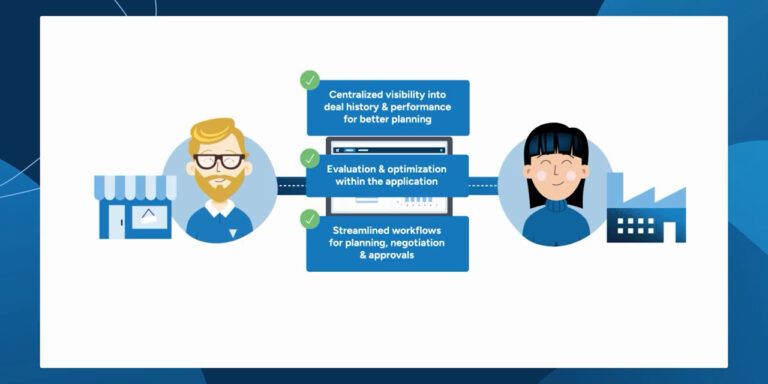How can retailers use real-time data to achieve merchandising success?
Oct 7, 2025 • 6 min
Real-time data and AI capabilities allow merchandisers to be more responsive, judicious, and accurate in their decision-making than ever before. Access to timely information from a single source of truth makes cross-collaboration between supply chain, inventory, allocation, and promotions much more coordinated and accurate.
Amanda Oren, VP of Industry Strategy in the US for RELEX, unpacks these benefits, positing that real-time data is a catalyst for more effective retail space utilization, promotions backed by sufficient inventory, and consistent product availability.
Listen to the whole conversation here:
Q: What real-time capabilities can retailers access today that simply weren’t around 5 or 10 years ago?
A: (Amanda) There’s been a lot of change in two key areas: the technology itself and how real-time the data is that we’re getting, plus the AI capabilities that exist today around merchandising that didn’t exist several years ago.
Take forecasting from RELEX, for instance. Retailers can now process and collect all sorts of real-time data streams, from weather updates to macroeconomic shifts or social media trends. Basically, anything that impacts demand. RELEX then automatically aggregates this data and applies machine learning to generate highly accurate forecasts capable of keeping up with an ever-evolving market. Five or ten years ago, that kind of functionality just really didn’t exist in the form that it does today.
And that’s just one example. There are so many other capabilities, including artificial intelligence and agentic AI, that can solve real-time merchandising problems in much more sophisticated and precise ways than was possible only a few years back.
Read more: How RELEX, built on AI, unlocks real business value
Q: What are the immediate competitive advantages for retailers in unifying merchandising and supply chain data?
A: (Amanda) Integrating your space allocation plan with your pricing and inventory strategies offers significant benefits. It helps you clearly identify which products belong in each store and at what price.
For some retailers, these decisions are often made in silos by different departments with different solutions that can’t communicate. This means the merchandising or marketing team might decide to run a promotion, but the inventory management team hasn’t been properly informed, so they don’t buy the necessary products. From the supply chain, you end up with insufficient stock to meet what’s needed for the promotion.
It is ideal to tie these activities together and align them with space allocation. For instance, if you’re running a promotion on a specific cereal brand, you’ll want to make sure that you’re putting it in the right end cap and in the right space from a promotional standpoint. You also want to be able to respond promptly when a product on promotion needs additional space for a particular amount of time.
Again, when those decisions are made in silos, it’s very hard to ensure that you have the right amount of product in the right spaces at the right time to always meet demand while minimizing waste.
Read more: How unified space optimization drives tangible results
Q: Are there real-world examples where this approach has substantially improved a retailer’s performance?
A: (Amanda) The one nearest and dearest to my heart, and also closest to me in proximity, is Sprouts Farmers Market. They’re a US grocer with around 460 locations across the US. They’ve been a longtime RELEX customer and have deployed our space and floor planning tool. They also use RELEX forecasting and replenishment capabilities on the distribution center and store side.
Sprouts is an excellent example of a customer who, from a merchandising perspective, has truly reaped the benefits of a unified data approach and combining our space and floor tool with our replenishment solution.
Sprouts improved forecast and replenishment accuracy with RELEX
Q: What happens when merchandising teams can finally act on the right data at the right time?
A: (Amanda) First, having the right data for assortments means they can make truly optimal decisions. This is foundational for merchandisers. It lets them confidently answer whether they have the right products in the right stores. RELEX space and assortment software helps retailers make exactly those types of decisions.
Merchandisers with real-time data will also understand better how to price items competitively while keeping their overall pricing strategy in mind. But data is also helpful from a promotional standpoint, as it shows which items have caught the market’s attention and which will have the largest impact on assortment and sales.
Finally, a retailer running promotions to drive store traffic will have a different strategy than one using promotions to boost the bottom line. So, to begin, you should define goals as an organization and ensure there’s consensus. Then, employ real-time data to build strategies and action plans to achieve those goals, whether for product selection, placement, store network distribution, or pricing and promotions.
Q: How does data-driven AI amplify human merchandising expertise to create breakthrough moments that weren’t possible before?
A: (Amanda) It’s all about working smarter, not harder. And it’s not so much about decreasing the hours going into operating a store or retailer. It’s much more about ensuring time is spent more efficiently and dedicated to strategic work.
Take store employees specifically—they may be spending an exorbitant amount of time updating prices or deciding what displays to build. AI can handle many of these decisions, giving employees more time to interact with customers and improve their shopping experience.
It used to be that they’d spend their time focusing on activities like how many avocados to order for Cinco de Mayo, and they would have to go out and collect the necessary information before making such a decision. But now, with AI at their fingertips, these employees can focus on the customer and develop a deeper understanding of their shopping habits and what’s needed to capitalize on them.
Q: Why is combining AI tools with unified data valuable for merchandising teams?
A: (Amanda) As mentioned, AI can aggregate reams of data and process it with a level of accuracy and speed previously not thought possible. This data is much more valuable when processed from one unified place. It aligns decisions and ensures they’re all made from the same information.
Instead of making decisions like what products to buy and where to send them in silos, they can instead be made in parallel with each other. More importantly, unified data ensures merchandisers make decisions that amplify each other’s impact—creating that “one plus one equals three” effect where the combined benefit exceeds the sum of individual improvements.
Through this approach, merchandisers will have fewer out-of-stocks, reduced waste, and see clear improvements to the customer experience. That’s where the unified piece really comes into play.
Q: What are the best practices for blending AI recommendations with merchandiser intuition to achieve measurable success?
A: (Amanda) One best practice in mind is optimizing assortment. Our solution is excellently positioned to help with two key areas for this activity: identifying which SKUs should no longer be part of the assortment (what we call SKU rationalization) and determining which stores should carry which items while recalibrating the existing assortment.
Merchandiser intuition should continue to play a pivotal role in identifying new items that don’t currently exist in the assortment and those that should be sourced from the market. This is where it really becomes a blend of art and science.
Many merchandisers and retailers attend trade shows, analyze syndicated data, and do competitive shopping. They’re looking for what’s trending, what’s growing fast, even if it’s still a small category, and most importantly, what would work specifically for their stores and customers. Because it’s not always the same across the board, that’s where intuition and what I’d call the “art” comes into play. It can’t just be about science.
The other critical piece is ensuring that when these AI tools roll out, there’s a properly considered change management and training process. This represents a massive shift for many in merchandising. They need to be on board with this AI disruption and truly understand the benefits, while remaining confident that their expertise is still extremely valuable. That’s absolutely essential for success.
Read more: How to help your organization successfully adopt and use new technology
Q: What should forward-thinking merchandising leaders focus on today to stay ahead of the curve?
A: (Amanda) Looking ahead, merchandisers should focus on the areas that will deliver the greatest return on investment—where they can secure those quick wins. There’s so much buzz around AI and its potential impact on business, with countless options available out there. Therefore, retailers should focus on areas where they can achieve the biggest bang for their buck with the fastest results. This way, they can confidently demonstrate to their organization and customers just how positively AI can make a difference. Once value has been shown, retailers can build on that momentum and take on bigger, more complex initiatives.



